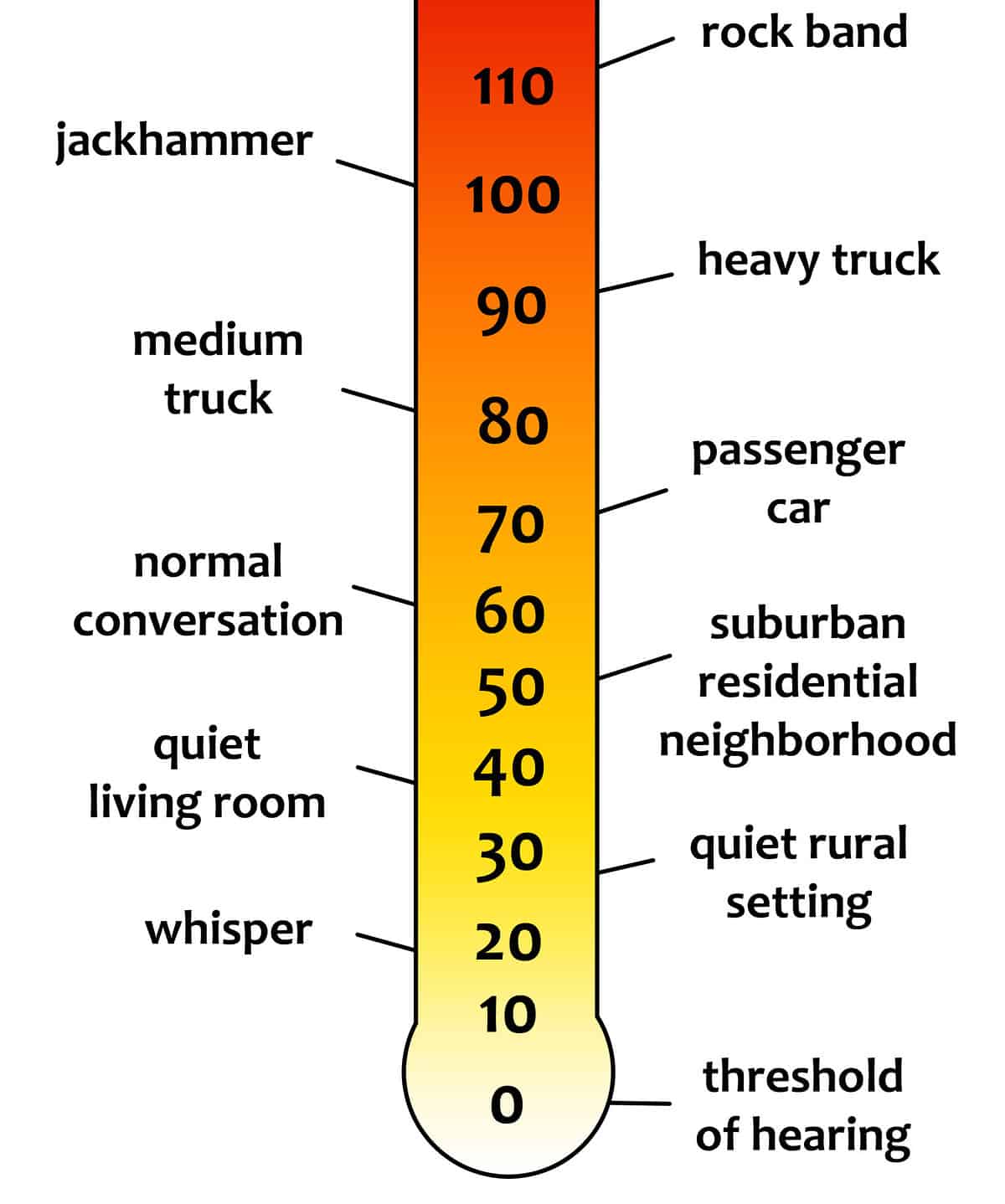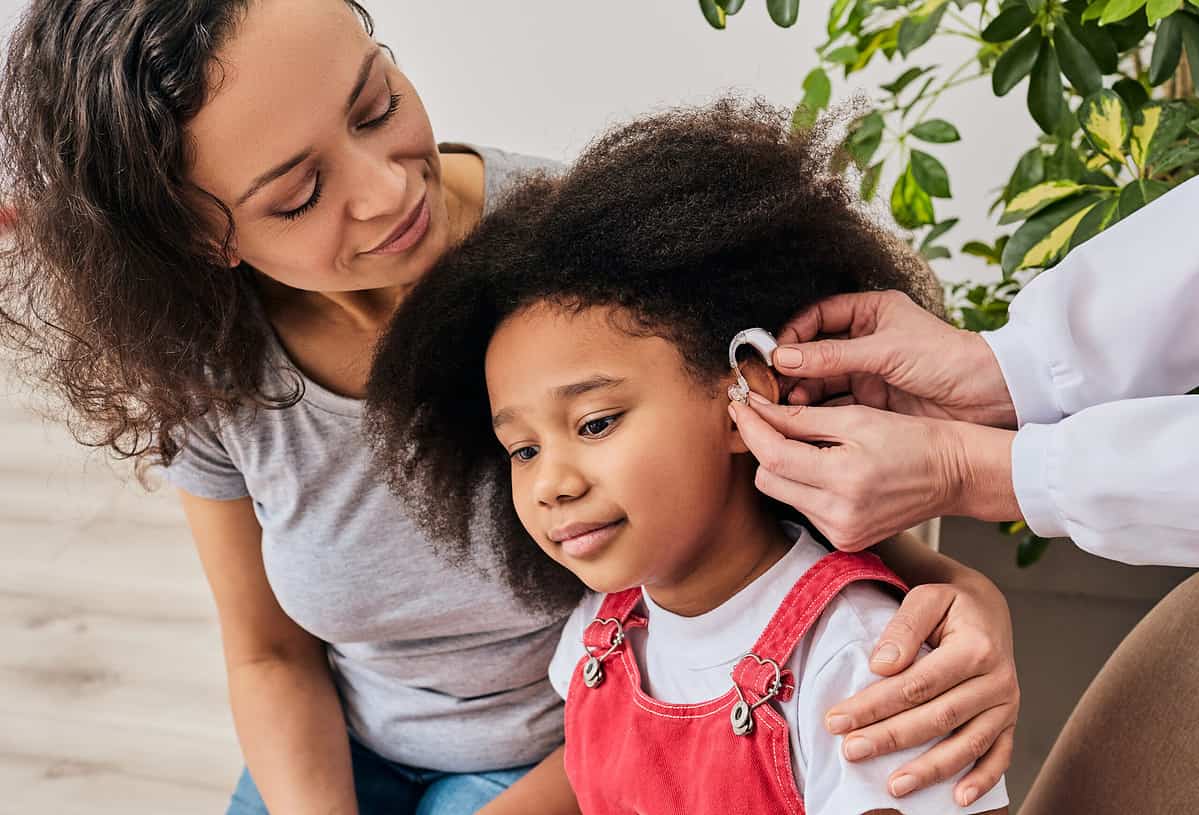From busy theme parks to crowded concerts, we’ve all been in a place where there was just too much noise. Especially as parents, we know this all too well considering how many times a day we ask our children to keep it down! Noises are all around us and sometimes, loud noises are unavoidable.
Have you ever wondered what amount of noise is actually safe? Understanding how noise levels can impact us is essential to protecting your ears and your children’s ears from hearing loss. Let’s take a look at a decibel chart and how we can use it to understand safe sound levels.

©desdemona72/Shutterstock.com
What is a decibel chart?
From the time we wake to the time we fall asleep, sounds surround us. Although some may be comforting to us, such as the peaceful sound of a bird singing outside, other sounds may be irritating. Like someone blasting music way too loud. No matter how loud or soft, decibels measure sounds, as they are measurement units that determine sound intensity. The louder the sound is, the higher the decibel will be. A decibel chart can help you determine what level of sound is safe and what level of sound may be dangerous.
How to use the decibel chart
Using a decibel chart is relatively simple. A decibel chart, like the one above, shows the level of intensity of some common sounds you might hear in different environments. These sounds on the chart can range from 0 decibels to 140 decibels and are typically divided into categories based on the decibel level. So let’s take a closer look at what each level of intensity means.
What each category means
The decibels on a decibel chart measure the intensity, or noise level, of different sounds. The louder the sound is, the higher the decibel will be. But how many decibels does it take for a sound to be a dangerous level of noise?
Here’s a look at each category on the decibel (dBA) chart:
- 0-40 decibels are low-intensity sounds.
- 50-60 decibels are medium-intensity sounds.
- 70-80 decibels are high-intensity sounds.
- 90-110 decibels is very loud.
- 120-140 decibels reach painful, dangerous noise levels.
While 0 decibels is generally the threshold of hearing, 140 decibels is the threshold of pain. Each category within the decibel chart represents a different level of intensity.
Most of the normal, everyday sounds fall within the soft to moderate levels, depending on your daily routine. If you work in a quiet office, most of your daily sounds fall within soft and safe noise levels. However, if you work on a construction site or as a school teacher, you’re exposed to sounds that are closer to the very loud category. This leads to the question of how sounds can impact our hearing and potentially cause hearing loss.

©Peakstock/Shutterstock.com
Can Loud Noises Cause Hearing Loss?
If you were growing up when headphones or earbuds became popular, you’ve likely had someone tell you to turn the sound down or you’ll hurt your ears. At the same time, if you’re the parent of teens or tweens, you may have told them the same. Can blasting music in your headphones, or other particularly loud noises, actually cause hearing loss?
The short answer is yes, loud noises impact your hearing and potentially cause hearing loss. But the amount of damage to your hearing will depend on the intensity of the sounds and the length of the exposure.
What Noises Can Cause Hearing Loss?
Normal, everyday sounds usually won’t damage your hearing or lead to hearing loss. If you’re regularly exposed to loud sounds or harmful noises for an extended period of time, hearing loss can occur.
Sounds in the average sound level, under 80 decibels, typically don’t cause hearing loss, even when they're a part of your regular routine. Sounds within the 80-85 range can cause hearing loss when exposed to them for 2 hours or more. However, when you start to get higher on the decibel chart, such as over 100 decibels, these types of sounds can cause hearing loss even after a few minutes of exposure.
Some of the loud noises you regularly hear might include music from a pair of headphones, the noise in a concert or restaurant, and in less frequent cases, the sound of power tools or fireworks. At 120-140 decibels or more, exposure to these sounds can cause immediate pain or ear injury.
How Does Hearing Loss Happen?
The cochlea is part of your inner ear that helps you hear. When you’re born, you have about 16,000 hair cells that cause your brain to detect sound. Hearing loss occurs when these hair cells are damaged beyond repair. Some hearing loss can be temporary, but when the cells or nerves in your ear become damaged, it often leads to permanent hearing loss. Even one-time exposure to extremely loud sounds can cause permanent damage.
Although you might think you’re not exposed to loud sounds on a regular basis, it’s important to protect your hearing and your children’s hearing from any possible damage. Let’s take a look at how you can protect yourself and your little ones from potential hearing loss.

©Kamil Macniak/Shutterstock.com
Tips for Protecting Your Hearing
Hearing may be something we often take for granted since we don’t think about how drastically our lives would change if we lost our hearing. It’s something we may have experienced if we have aging parents or older relatives in our family.
Thankfully, technology advancements have led to hearing aids that have helped many people with hearing loss. However, considering most of our social interactions depend on the ability to hear, we can recognize how important protecting our hearing is. Here are some tips for protecting your hearing from dangerous levels of noise and potential damage:
Get Your Hearing Checked Regularly
Regular hearing checks are critical when it comes to protecting your hearing. If you’re already experiencing hearing loss, visiting an audiologist is the best way to prevent any further damage and assess your current hearing loss. Even if you don’t notice hearing loss, getting regular checks is still important. Up to 50% of the hair cells in your ear can be damaged before you notice any change in your hearing.
Wear Hearing Protection in Loud Environments
Not all loud noises can be avoided. Further, no matter how hard you work to protect your hearing, dangerous noise levels may still impact you at some point. However, if you know you’ll be in a place where there will be loud noises, always wear hearing protection. For example, if you’ll be on a construction site or at a concert, bring hearing protection devices with you. Keep in mind that regular headphones or earbuds are not designed to protect your hearing. Make sure you choose hearing protection that is tested and provides a noise reduction rating.
Limit the Amount of Time Spent in Loud Environments
There are some sounds that only cause hearing loss after a certain amount of exposure, and that’s why it’s important to limit your exposure to dangerous sounds. If you listen to loud music one time, you may not experience hearing loss. But if blasting loud music in your headphones is part of your daily routine, you’re more likely to experience some loss. When you can’t avoid exposure to loud sounds, remove yourself from the environment as quickly as possible.
Turn Down the Volume
We’ve probably all experienced the joys of listening to music, sometimes a little too loud, in our headphones or in the car. Unfortunately, how loud your volume is can cause hearing loss. This is especially true if you’re exposed to it for a long period of time. One of the best ways to protect your hearing long-term is to turn down the volume. You can still enjoy your music at a lower volume, and keeping the volume at a safe level means you can listen to it without experiencing hearing damage.
Takeaway
Noises are everywhere! Often, when they’re too loud, they can annoy us. Think of your irritation, though, as your body protects you from potential hearing loss. If you want to make sure your hearing is in top shape, get hearing checks regularly and limit your exposure to loud noises.
If you want to measure the decibel of the sounds in your everyday life, you can use a sound meter. You can also download an app that measures decibels. Refer back to this decibel chart to check out whether the sounds are safe or getting a little too loud.
The image featured at the top of this post is ©Edgar BJ/Shutterstock.com.
